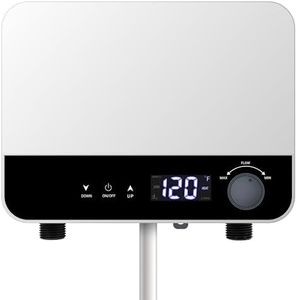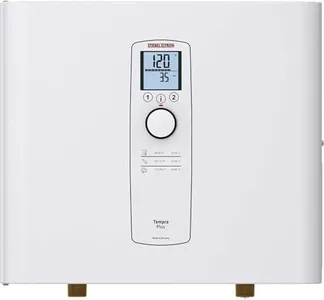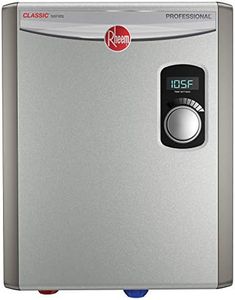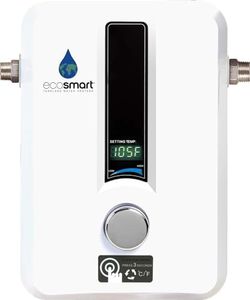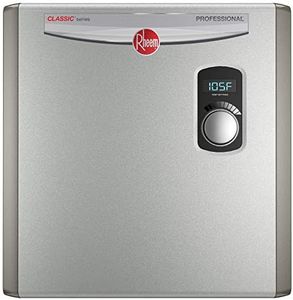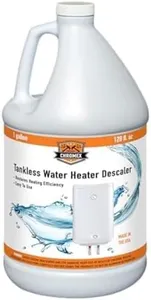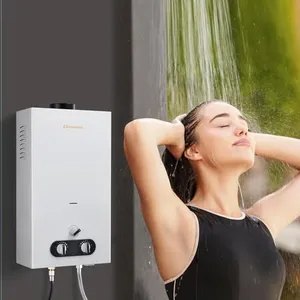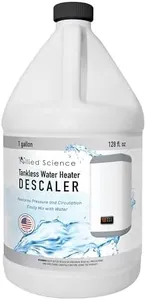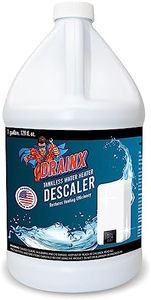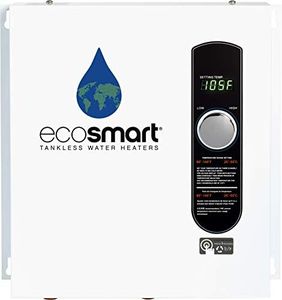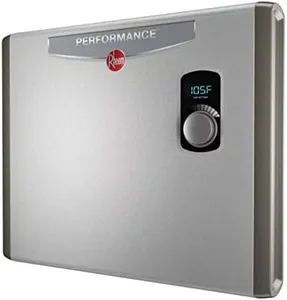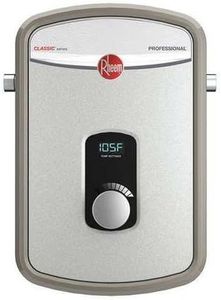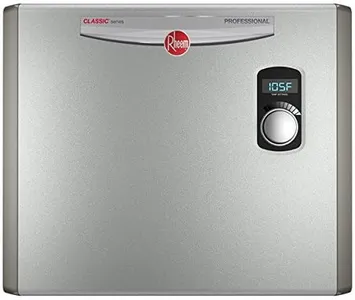10 Best Electric Tankless Water Heater 2025 in the United States
Our technology thoroughly searches through the online shopping world, reviewing hundreds of sites. We then process and analyze this information, updating in real-time to bring you the latest top-rated products. This way, you always get the best and most current options available.

Our Top Picks
Winner
Stiebel Eltron 239223 Tankless Water Heater – Tempra 29 Plus – Electric, On Demand Hot Water, Eco, White, 23
Most important from
2063 reviews
The Stiebel Eltron 239223 Tempra 29 Plus is a high-performing electric tankless water heater that provides an on-demand and continuous supply of hot water. It features a sleek, space-saving design and does not require venting, which makes it versatile for various home installations. This model has a maximum flow rate of 3 gallons per minute (GPM), making it suitable for households with moderate hot water needs.
Its power rating is substantial, operating at 28.8 kW, which ensures a quick temperature rise but also means it requires a significant electrical setup: 240-volt service, three dedicated 40 amp breakers, and at least 200 amp total service to the home. This could be a hurdle for some installations and might require professional electrical work to update the home's capacity.
The unit features two temperature memory presets, providing convenience for users with different hot water preferences. It also has a useful LED display for easy monitoring and adjustments. Energy efficiency is a highlight, as tankless systems generally save on energy compared to traditional tank heaters by only heating water as needed. Potential buyers should consider the installation requirements carefully. This unit is most beneficial for medium to large households that can support the electrical demands, and who are looking for a reliable, space-saving, and energy-efficient solution for their hot water needs.
Most important from
2063 reviews
Stiebel Eltron Tankless Water Heater – Tempra 24 Plus – Electric, On Demand Hot Water, Eco, White, 20.2
Most important from
2063 reviews
The Stiebel Eltron Tankless Water Heater - Tempra 24 Plus is a solid choice for anyone looking for an electric water heater that offers on-demand hot water. One of its standout features is the continuous flow technology that ensures a consistent water temperature, making it ideal for families who need uninterrupted hot water during showers or other tasks. With its compact design, this unit saves space, and since it doesn’t require venting, installation is generally straightforward, which can be a major plus for homeowners.
Energy efficiency is another strong point, as it utilizes auto-modulation to control water flow and reduce energy consumption. The included savings monitor is a nice touch, helping you track energy savings over time. Additionally, the digital temperature display and preset options enhance usability, making it easy to adjust settings to your preference. The safety feature allowing you to limit the maximum temperature is a thoughtful addition, particularly for homes with young children.
On the downside, you need to ensure your electrical system can support this unit, as it requires a minimum service of 150 amps, which may necessitate an upgrade for some homes. While it performs well within its capacity, it’s important to note that the flow rate may decrease if multiple outlets demand hot water simultaneously, so larger households with high simultaneous usage might experience some limitations. The warranty offered provides peace of mind, covering leakage for seven years and parts for three years, indicating the manufacturer’s confidence in the product’s durability. Potential buyers should consider whether the installation costs and electrical requirements align with their home setup. The Tempra 24 Plus is a reliable, energy-efficient option for those who need a steady supply of hot water and have compatible electrical infrastructure.
Most important from
2063 reviews
Rheem 18kW 240V Tankless Electric Water Heater, Gray
Most important from
1938 reviews
The Rheem 18kW 240V Tankless Electric Water Heater is a solid choice for those looking for an efficient and space-saving water heating solution. One of its standout features is the impressive flow rate of up to 4.4 gallons per minute (GPM), which makes it suitable for smaller households or apartments where demand for hot water isn't excessively high. Its energy efficiency rating of 99.8% is quite remarkable, meaning you'll likely save on your energy bills compared to traditional tank heaters. The self-modulation technology adjusts the power based on hot water demand, which further optimizes energy use.
The external digital control with an LED display is user-friendly, allowing for precise temperature settings within a +/- 1-degree accuracy. This feature is particularly beneficial for those who want to maintain consistent hot water temperatures. The installation is straightforward as well, with bottom connections that make it easier to replace or service when needed.
There are a few drawbacks to consider. While the 4.4 GPM flow rate is adequate for smaller setups, larger families or homes with multiple bathrooms may find it insufficient during peak usage times. Additionally, being an electric unit, it may not be the best option for locations where electricity supply is unreliable or insufficient to support its high wattage of 18,000 watts. Lastly, while the unit is compact, its installation does require adequate space and professional help, especially for wall mounting, which could be a consideration for DIY enthusiasts.
Most important from
1938 reviews
Buying Guide for the Best Electric Tankless Water Heater
Choosing the right electric tankless water heater can significantly impact your comfort and energy efficiency at home. These devices heat water on demand, which means you won't run out of hot water and you can save on energy costs since there's no need to keep a large tank of water hot at all times. However, selecting the right model involves understanding several key specifications to ensure it meets your household's needs.FAQ
Most Popular Categories Right Now
